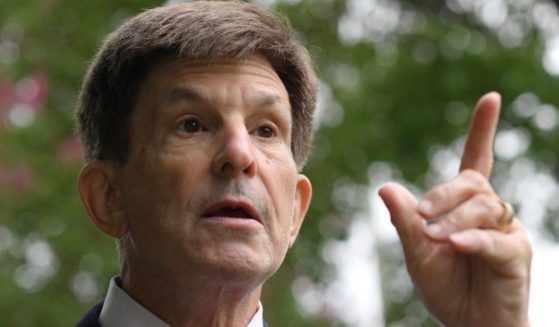
2024 Election: Trump Gains Major Ground with Young People from 3 Key Voting Demos
President Joe Biden’s catastrophic administration has left young Americans of nearly every description seeking an alternative.
In fact, according to the GenForward May 2024 survey of 2,089 adults aged 18-40, Biden’s 2020 coalition of young black, Latinx (a gender-neutral term for people of Latin American heritage) and Gen Z voters in general has evaporated, leaving the octogenarian Democrat in an overall statistical tie with former President Donald Trump five months before the 2024 presidential election.
Created by University of Chicago political scientist Cathy J. Cohen and administered by the university’s National Opinion Research Center, the survey helped quantify the magnitude of young voters’ flight from the Biden camp, as well as the reasons for their exodus.
All told, 1,461 of those 2,089 adults cast votes in 2020. And only 11 percent of the survey’s respondents indicated that they “probably” or “definitely” would not vote in 2024. Conversely, 68 percent answered that they “probably” or “definitely” will vote. Thus, a strong majority of respondents qualified as likely voters.
The survey, conducted May 10-22, divided respondents into 11 categories: four racial or ethnic groups (black, Latinx, Asian-American/Pacific Islander, white), two sexes (male and female, thankfully), three political affiliations (Democrat, independent, Republican) and two age groups (18-26, 27-40). Those two age groups roughly correspond to Gen Z (18-26) and millennials (27-40).
In the 2020 presidential election, Biden won ten of those 11 categories by significant percentages.
For instance, Gen Z voters chose Biden by a 26-point margin (59-33), young Latinx voters by 40 points (67-27) and young black voters by a gargantuan 63 points (77-14). In fact, Biden’s narrowest margins came with young whites (53-37) and young independents (48-28). Even 39 percent of young Republicans opted for Biden, compared to 56 percent for Trump.
Overall, voters aged 40 and under preferred Biden by a whopping 29 points (60-31).
According to the GenForward survey, however, the president’s polling advantage among young voters has not only shrunk but disappeared altogether.
Remarkably, in a 2024 contest that includes independent candidates Robert F. Kennedy Jr. and Cornel West, Gen Z and Latinx respondents actually preferred Trump by narrow margins of 33-32 and 32-28, respectively. Meanwhile, among young black respondents, Biden’s lead over Trump has shrunk to only ten points (33-23).
In sum, Biden faces staggering net losses with Gen Z (27 points), Latinx (44 points) and black voters (53 points).
Likewise, Trump now holds a 14-point lead among independents and a 1-point lead among whites. Male, female and millennial respondents have abandoned Biden in roughly the same numbers.
All told, Biden’s 29-point advantage among young voters has shrunk to only two points overall, 33-31.
Furthermore, those young voters identified the failure of Bidenomics as the primary reason for their abandonment of the president.
From a list of 21 possibilities, survey respondents chose inflation as the most important election issue. And they did so by a wide margin, with little variation across categories. For instance, inflation ranked as the most important election issue for exactly 19 percent of Latinx, white, male and millennial respondents.
Overall, 18 percent of respondents identified inflation as the most important issue, followed by economic growth at 11 percent.
Alas, the survey did feature at least three shortcomings.
First, the respondents hardly reflected a proportional representation of the electorate.
For instance, the survey included responses from 571 whites and 424 people classified as Asian-American or Pacific Islanders. According to Axios, the U.S. population as of July 1, 2022, featured 251.6 million whites and roughly 21 million AAPI.
Skin color, of course, should have no bearing on votes or on much of anything, for that matter. But the survey did divide people in that way and thus gave disproportionate weight to AAPI respondents.
On balance, that probably exaggerated the overall amount of support for Biden. After all, AAPI respondents also abandoned the president, but they still preferred him by a healthy 45-18 margin over Trump.
Other internal survey evidence might explain why. For instance, when asked about their level of concern about being able to pay an unexpected bill for $1,000 right away, 33 percent of AAPI respondents answered “not at all worried,” compared to only 15 percent of black and 13 percent of Latinx respondents who expressed such peace of mind. Conversely, 33 percent of black, 27 percent of Latinx and 26 percent of white respondents answered “extremely worried,” compared to only 9 percent of AAPI respondents.
In other words, the survey appears to have over-represented not only young AAPI voters in general but affluent ones. Hence their support for Biden, the choice of the establishment.
Second, respondents of every description expressed substantial support for someone other than the four candidates listed. From this perspective, their support for Trump appears less firm than the shifting numbers might suggest.
For instance, Biden’s support among young independents fell from 48 percent to 14 percent. But Trump’s support among that same group held steady at 28 percent. A remarkable 40 percent of independents chose “someone else” as their preferred candidate. Thus, Trump experienced a 34-point net gain but no new actual voters. And the same pattern prevailed in most other categories.
On the other hand, Trump has lost no meaningful support from young voters who formed part of his 2020 coalition.
More importantly, two categories of young voters have indeed flocked to Trump. In absolute terms, as opposed to merely net gains, the former president saw his support increase by 5 percent among young Latinx voters and by 9 percent among young black voters.
Thus, broad preference for “someone else” should not obscure the shift of black and Latinx support from Biden to Trump.
Third, GenForward conducted the survey before a Manhattan jury saddled Trump with a guilty verdict in a sham criminal trial.
Despite these shortcomings, the survey has tremendous value as a snapshot of the young electorate and its collective mood.
For one thing, it conformed to other recent polling data.
In a May 21-23 NPR/PBS/Marist poll, for instance, respondents aged 18-29 gave Biden by far his lowest approval rating at only 24 percent, compared to 63 percent who expressed disapproval of his job performance. Meanwhile, respondents 60 and older indicated their net approval by a slim margin of 49-48.
Likewise, when asked about a potential guilty verdict in the New York hush-money trial, 17 percent of all respondents to the NPR/PBS/Marist poll indicated that such a verdict would make them less likely to vote for Trump. But another 67 percent said it would make no difference. And 15 percent answered that it would make them more likely to vote for the former president.
In other words, the Biden administration’s Soviet-style tactics have not diminished Trump’s growing appeal, especially among young voters.
Indeed, the GenForward survey confirmed as much with a series of nine issue-specific and job performance-related questions.
When asked which candidate they regarded as most capable of being a strong leader, for instance, respondents chose Trump by a 16-point margin over Biden, 35-19. Trump also prevailed on immigration (34-21), the war in Gaza (29-15) and even protecting democracy (28-26). That last figure showed, at least, that the establishment’s Trump-as-a-threat-to-democracy propaganda has had minimal effect.
In fact, respondents chose Trump over Biden on every issue except “a woman’s right to choose.”
On inflation, which they identified as the election’s most important issue, they gave Trump a 33-18 advantage.
And they certainly had it right. Inflation, after all, amounts to retroactive enslavement. We work, we receive compensation, and then elected officials erode the value of that compensation — and thus the value of our labor — by printing money and sending it to Ukraine or anywhere else that war profiteers might enrich themselves. Then, they redistribute the remainder of that wealth upward with a gargantuan national debt requiring large interest payments.
For history’s corrupt ruling classes, that pattern has never changed. Young people might not know the exact pattern, but they have begun to recognize its effects. And that bodes poorly for Biden.
Truth and Accuracy
We are committed to truth and accuracy in all of our journalism. Read our editorial standards.
Advertise with The Western Journal and reach millions of highly engaged readers, while supporting our work. Advertise Today.












